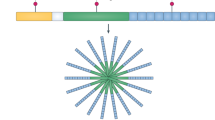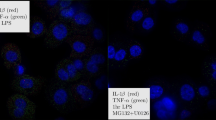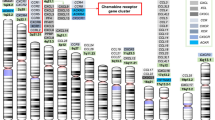Abstract
Background:
Mevalonate kinase deficiency (MKD) is a rare genetic autoinflammatory disease caused by blocking of the enzyme mevalonate kinase in the pathway of cholesterol and isoprenoids. The pathogenic mechanism originating an immune response in MKD patients has not been clearly understood.
Methods:
We investigated the dysregulation of expression of selected cytokines and chemokines in the serum of MKD patients. The results have been compared with those observed in an MKD mouse model obtained by treating the mice with aminobisphosphonate, a molecule that is able to inhibit the cholesterol pathway, mimicking the genetic block characteristic of the disease.
Results:
Interleukin (IL)-1β, IL-5, IL-6, IL-9, IL-17, granulocyte colony–stimulating factor, monocyte chemotactic protein-1, tumor necrosis factor-α, and IL-4 expression were dysregulated in sera from MKD patients and mice. Moreover, geraniol, an exogenous isoprenoid, when administered to MKD mice, restored cytokines and chemokines levels with values similar to those of untreated mice.
Conclusion:
Our findings, which were obtained in patients and a mouse model mimicking the human disease, suggest that these cytokines and chemokines could be MKD specific and that isoprenoids could be considered as potential therapeutic molecules. The mouse model, even if with some limitations, was robust and suitable for routine testing of potential MKD drugs.
Similar content being viewed by others
Log in or create a free account to read this content
Gain free access to this article, as well as selected content from this journal and more on nature.com
or
References
Goldstein JL, Brown MS . Regulation of the mevalonate pathway. Nature 1990;343:425–30.
Fears R . The contribution of the cholesterol biosynthetic pathway to intermediary metabolism and cell function. Biochem J 1981;199:1–7.
Drenth JP, van der Meer JW, Kushner I . Unstimulated peripheral blood mononuclear cells from patients with the hyper-IgD syndrome produce cytokines capable of potent induction of C-reactive protein and serum amyloid A in Hep3B cells. J Immunol 1996;157:400–4.
Frenkel J, Rijkers GT, Mandey SH, et al. Lack of isoprenoid products raises ex vivo interleukin-1beta secretion in hyperimmunoglobulinemia D and periodic fever syndrome. Arthritis Rheum 2002;46:2794–803.
Mandey SH, Kuijk LM, Frenkel J, Waterham HR . A role for geranylgeranylation in interleukin-1β secretion. Arthritis Rheum 2006;54:3690–5.
Kuijk LM, Mandey SH, Schellens I, et al. Statin synergizes with LPS to induce IL-1β release by THP-1 cells through activation of caspase-1. Mol Immunol 2008;45:2158–65.
Drenth JP, Vonk AG, Simon A, Powell R, van der Meer JW . Limited efficacy of thalidomide in the treatment of febrile attacks of the hyper-IgD and periodic fever syndrome: a randomized, double-blind, placebo-controlled trial. J Pharmacol Exp Ther 2001;298:1221–6.
Bodar EJ, van der Hilst JC, Drenth JP, van der Meer JW, Simon A . Effect of etanercept and anakinra on inflammatory attacks in the hyper-IgD syndrome: introducing a vaccination provocation model. Neth J Med 2005;63:260–4.
Marcuzzi A, Pontillo A, De Leo L, et al. Natural isoprenoids are able to reduce inflammation in a mouse model of mevalonate kinase deficiency. Pediatr Res 2008;64:177–82.
Marcuzzi A, Tommasini A, Crovella S, Pontillo A . Natural isoprenoids inhibit LPS-induced-production of cytokines and nitric oxide in aminobisphosphonate-treated monocytes. Int Immunopharmacol 2010;10:639–42.
Marcuzzi A, Crovella S, Pontillo A . Geraniol rescues inflammation in cellular and animal models of mevalonate kinase deficiency. In Vivo 2011;25:87–92.
Marcuzzi A, De Leo L, Decorti G, Crovella S, Tommasini A, Pontillo A . The farnesyltransferase inhibitors tipifarnib and lonafarnib inhibit cytokines secretion in a cellular model of mevalonate kinase deficiency. Pediatr Res 2011;70:78–82.
De Leo L, Marcuzzi A, Decorti G, Tommasini A, Crovella S, Pontillo A . Targeting farnesyl-transferase as a novel therapeutic strategy for mevalonate kinase deficiency: in vitro and in vivo approaches. Pharmacol Res 2010;61:506–10.
Yu Z, Funayama H, Deng X, et al. Comparative appraisal of clodronate, aspirin and dexamethasone as agents reducing alendronate-induced inflammation in a murine model. Basic Clin Pharmacol Toxicol 2005;97:222–9.
Drenth JP, van Deuren M, van der Ven-Jongekrijg J, Schalkwijk CG, van der Meer JW . Cytokine activation during attacks of the hyperimmunoglobulinemia D and periodic fever syndrome. Blood 1995;85:3586–93.
Chomarat P, Banchereau J . An update on interleukin-4 and its receptor. Eur Cytokine Netw 1997;8:333–44.
Dinarello CA, Elin RJ, Chedid L, Wolff SM . The pyrogenicity of the synthetic adjuvant muramyl dipeptide and two structural analogues. J Infect Dis 1978;138:760–7.
Ahmad ST, Arjumand W, Seth A, et al. Preclinical renal cancer chemopreventive efficacy of geraniol by modulation of multiple molecular pathways. Toxicology 2011;290:69–81.
Ong TP, Heidor R, de Conti A, Dagli ML, Moreno FS . Farnesol and geraniol chemopreventive activities during the initial phases of hepatocarcinogenesis involve similar actions on cell proliferation and DNA damage, but distinct actions on apoptosis, plasma cholesterol and HMGCoA reductase. Carcinogenesis 2006;27:1194–203.
Cuisset L, Drenth JP, Simon A, et al.; International Hyper-IgD Study Group. Molecular analysis of MVK mutations and enzymatic activity in hyper-IgD and periodic fever syndrome. Eur J Hum Genet 2001;9:260–6.
Houten SM, Koster J, Romeijn GJ, et al. Organization of the mevalonate kinase (MVK) gene and identification of novel mutations causing mevalonic aciduria and hyperimmunoglobulinaemia D and periodic fever syndrome. Eur J Hum Genet 2001;9:253–9.
Deng X, Yu Z, Funayama H, et al. Mutual augmentation of the induction of the histamine-forming enzyme, histidine decarboxylase, between alendronate and immuno-stimulants (IL-1, TNF, and LPS), and its prevention by clodronate. Toxicol Appl Pharmacol 2006;213:64–73.
Härtel C, Adam N, Strunk T, Temming P, Müller-Steinhardt M, Schultz C . Cytokine responses correlate differentially with age in infancy and early childhood. Clin Exp Immunol 2005;142:446–53.
Author information
Authors and Affiliations
Corresponding author
Rights and permissions
About this article
Cite this article
Marcuzzi, A., Zanin, V., Kleiner, G. et al. Mouse model of mevalonate kinase deficiency: comparison of cytokine and chemokine profile with that of human patients. Pediatr Res 74, 266–271 (2013). https://doi.org/10.1038/pr.2013.96
Received:
Accepted:
Published:
Issue date:
DOI: https://doi.org/10.1038/pr.2013.96
This article is cited by
-
Anti-inflammatory and cytoprotective effects of a squalene synthase inhibitor, TAK-475 active metabolite-I, in immune cells simulating mevalonate kinase deficiency (MKD)-like condition
SpringerPlus (2016)
-
Natural history of mevalonate kinase deficiency: a literature review
Pediatric Rheumatology (2016)
-
Hyper-IgD syndrome/mevalonate kinase deficiency: what is new?
Seminars in Immunopathology (2015)
-
Comparison of plant-based expression platforms for the heterologous production of geraniol
Plant Cell, Tissue and Organ Culture (PCTOC) (2014)



